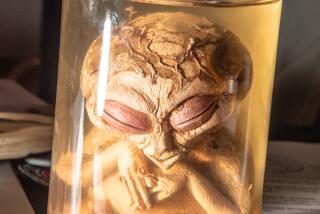Cosmic Design or Mere Coincidence? Consider the Numbers
- Share via
This month, all nine planets cluster together in one small swath of the sky. My new friend’s neighbor has a cat with the same name as mine. My stepdaughter in New Jersey and a psychologist friend in L.A. are expecting a baby on the same day.
Are these portentous cosmic occurrences? Or merely curious coincidences?
It’s not an idle question. Much of science involves trying to determine which events are connected by common causes, and which are linked only by the luck of the draw.
“In mathematics, in science, and in life, we constantly face the delicate, tricky task of separating design from happenstance,” writes Ivars Peterson in his latest book, “The Jungles of Randomness: A Mathematical Safari.”
Is a cluster of cancer cases in a particular town the result of toxic residues, or a normal blip in the distribution of disease? Are those black spots in the photograph evidence that house-sized snowballs are raining on Earth, or random noise in the detector?
Mathematics can help sort out these scenarios. Indeed, a little mathematical know-how may be the only known antidote to a pervasive frailty of the human mind: the perception of causes and connections behind purely chance events.
As Peterson, the mathematics and physics editor for Science News, points out, human beings are programmed to perceive patterns in chaotic events--the better to make sense of an often confusing visual world. They see forms in cracks on the ceiling, faces on the moon, woolly sheep in clouds. They group clusters of adjacent stars into images of warriors and serpents and dippers in the sky.
*
“Humans are predisposed to seeing order and meaning in a world that too often presents random choices and chaotic evidence,” he writes.
Indeed, most “amazing coincidences” are created in the mind--like the constellations in the sky--from the human tendency to find plausible links between objects and events.
Consider two strangers sitting in adjoining seats on airplane. What are the chances that they will have something in common?
Given the vast number of possibilities--from shared favorite authors to hometowns, past lovers and current jobs, schools and acquaintances--it can be shown that in 99 times out of 100 the two passengers will be linked in some way by less than two intermediaries, according to mathematician John Allen Paulos.
The number of things the two people don’t share will vastly outweigh the number of things they do. But only the shared links will be remembered as “amazing coincidences.”
The same is true, Paulos says, of prophetic dreams. Often, people will dream about, say, an earthquake or a plane crash, only to read in the paper the next day that it actually happened. But given the fact that roughly 250 million people in the U.S. spend several hours in dreamland each night, “we should expect as much,” he says. “In reality, the most astonishingly incredible coincidence imaginable would be the complete absence of coincidence.”
*
Sometimes, coincidences do point to deep truths. Einstein, for example, was bothered by the well-known fact that gravity and inertia balance out exactly in our universe. That is why a bowling ball and a golf ball dropped from a high shelf hit the ground at the same time--because while gravity pulls harder on the bowling ball, inertia endows the bowling ball with a greater resistance to being pulled.
Einstein thought this uncanny equivalence had to be more than a funny coincidence--and came up with the idea that both gravity and inertia are aspects of a bigger picture--the curvature of space-time.
In the same way, there is a lot more than coincidence behind the fact that more smokers than nonsmokers get lung cancer. Sometimes coincidence does point to a cause.
How can one tell the difference between coincidences based on cause and those based on chance? Statisticians use all kinds of filters to determine which is which, but even the mathematically immune can use some easy tricks to keep from getting fooled.
For example, they can remember that large numbers of anything are bound to create “coincidences.” For example, it is certain that at least 250 of the 250 million people living in the United States will experience a one-in-a-million “coincidence” every day--purely by chance.
And while the chance that any one person will win the lottery twice in the same year is astronomical, the chance that any of the millions of previous lottery winners will win another lottery in their lifetime is pretty good.
The fact is, events that people normally think of as highly unlikely are often very likely. If someone flips a coin a hundred times, the chances of coming up with a long string of heads or tails are more likely than not. It’s not an “amazing coincidence.” It’s just nature behaving normally.
Or as mathematician Persi Diaconis of Harvard puts it: “The world’s activity and our labeling of events generates the coincidences.”






